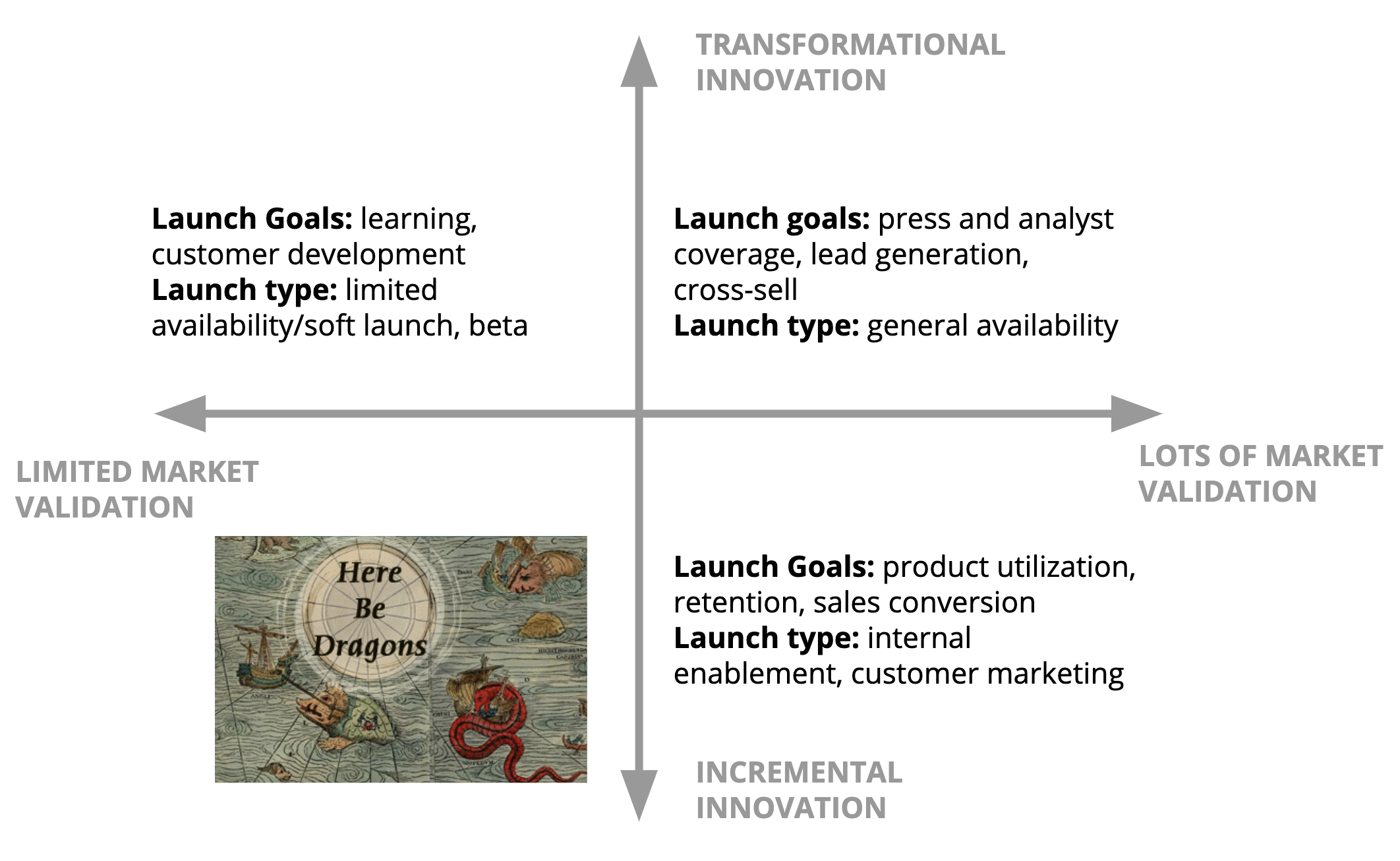If you’re a marketer at a B2B SaaS company, the scenario is familiar.
The date for the big product launch approaches. The marketing team feverishly crosses items off the launch checklist: finalizing the press release, readying the new website copy, and preparing the new sales slides. Finally, amid a flurry of last-minute coordination across engineering, PM, and marketing, the new functionality officially goes live.
Congratulations! Now what? Did the launch “work”?
Product launches are one of the most daunting challenges facing early-stage companies. That’s largely because they defy one-size-fits-all playbooks. There are countless ways to launch products, each with different objectives and tactics. Even a single product launch involves the strategic exchange of information with many different audiences and stakeholders. Factor in the rapid pace of SaaS innovation, and you’ve got a recipe for immense complexity.
But despite their challenges, product launches don’t have to be a pain for your marketing team. What are some of the common challenges that early-stage B2B SaaS companies face – and how can they overcome them?
Misstep #1: Launching when something is done
Early-stage companies often do themselves a disservice by assuming that engineering delivery and product launch activities should always go tightly hand in hand. In other words, things get publicly launched when the engineer work is done – and only new things get launched. This deprives companies of the opportunity to find the right moment to “land” a major release, or to resurface functionality that might have renewed market relevance.
What to do instead: Focus on strategic moments to capture your target audience’s attention: a major industry conference, a user summit, or an upcoming analyst briefing or publication, for example. One Blue Seedling client, for example, targeted a major industry conference as the platform for unveiling a new product release. They dangled the promise of an “exclusive sneak peek” at new technology as a hook to set up meetings with qualified prospects. And as for re-launching old tech: one SaaS company that we know successfully repackaged existing but lightly-used functionality as part of a workflow for a new target persona. This is an especially applicable tactic in COVID times, when a changing landscape may mean different workflows and user needs.
Misstep #2: Not having clear goals
Organizations often assume that there is a single universal set of goals – and therefore a single global launch checklist – for all releases. In reality, product launches can have vastly different objectives. Sometimes the goal is to secure favorable industry analyst coverage. Other times it’s to drive industry press coverage to increase top-of-funnel velocity, or to increase utilization or drive cross-sell amongst the existing customer base. Each of those goals implies a different set of channels and tactics.
What to do instead: Get clear on your launch objectives. The 2×2 matrix below provides a starter framework. It assumes that as you prepare to launch, you have a sense of how innovative your new capabilities are. Are they trailblazing, front-page news (like self-driving cars) – or more of a usability benefit to customers already familiar with your core offerings (like a new navigation shortcut)? Second, it assumes that you have some sense of market validation. How comfortable are you marketing, selling, and servicing the new capabilities? Do you know how to price them? Have you ever pitched them to a prospect in your target market before?

The answer to these questions generally guides your launch goals and strategy:
- Top right (significant innovation with lots of market validation): A classic “big splash” product launch with press, demand generation campaigns, field and partner enablement, and more. Example: Criteo’s release of Traffic Generation
- Bottom right (incremental innovation with lots of market validation): Typically usability or performance-oriented features requested by current customers – or specific requests made by sales prospects. Example: Heap’s release of Account Health Analysis
- Top left (significant innovation with limited market validation): A visionary new product that requires customer and prospect input on pricing, packaging, and servicing. Example: Pendo’s release of Visual Design Studio
- Bottom left (incremental innovation with limited market validation): Generally not worth building or launching
Misstep #3: Focusing on capabilities
When releasing a new product that’s the culmination of weeks or months of engineering work, it’s natural to highlight technical innovations. Internal teams may feel comfortable talking about the technical componentry, but aren’t yet confident articulating key use cases. In both cases the outcome is the same. The “why” (the business outcomes that your new features unlock for users) ends up getting eclipsed by the “how.” This is problematic because it shifts focus away from the value of your offering, reducing your product to a shiny nice-to-have and siphoning off urgency from the sales process.
What to do instead: Before you begin planning activities, start by writing the press release you’d like to accompany the launch. This trick, part of the Amazon product management arsenal, anchors you to the “so what” – the tangible difference that your innovation makes in the lives of your customers and prospects. One Blue Seedling customer, for example, discovered through the process of writing the press release that a new UI didn’t just deliver a better experience for existing users. It also meant that entirely new users with less technical training could set up and manage data flows for the first time. Suddenly the product launch became not just about snazzy drag-and-drop tooling, but about democratizing data access within the enterprise: a much more valuable pain point to solve.
Misstep #4: Telling the story yourself
Companies often make their own executives the face of high-profile launches – conducting analyst briefings and giving interviews and sound bites to the press. This is helpful as a show of leadership’s commitment to the launch, but often not enough to secure top-tier press coverage or generate sustained market interest, especially in crowded spaces where prospects are naturally wary of claims from SaaS vendors.
What to do instead: Marketing should insist on owning “customer development” for a launch of any reasonable magnitude. Customer development – the process of nurturing customers, often as part of a beta program, to provide early feedback and advocacy for your product – is time-consuming. But unless you’re Salesforce, meaningful social proof (named case studies, reference customers, quotes for press releases) will also immediately deliver superior results for any product launch: helping land better press coverage, facilitate lead gen, and drive new logo acquisition.
Misstep #5: Neglecting the most important audience
Amidst all the focus on making noise in the market, it can be easy to forget what is arguably the most important audience for any product release: internal stakeholders. Your employees – especially field-facing teams – represent the voice of your brand and value proposition to the market. Too often, they’re left without adequate tools to advocate on behalf of new product functionality.
What to do instead: The anchor of any major product launch should be internal education and enablement. We recommend accompanying the press release that you write (see Misstep #3 above) with an FAQ document that lays out anticipated questions and objections – all with key talking points. This kind of “source of truth” documentation becomes the shared messaging framework for the entire company. One Blue Seedling customer that started with this messaging framework observed that it helped customer success representatives more effectively identify and act on cross-sell opportunities within their accounts.
The Bottom Line
Product launches are an incredible opportunity for early-stage SaaS companies to tell the story of their product vision and evolution. Avoiding these common missteps can help you make them a powerful tool in your overall marketing strategy.
Further Reading
- The launch campaign checklist – how to ensure you’re ticking all the boxes for your next marketing launch
- Podcast about operating cadence – how to sync product, marketing, sales, and finance on one calendar
- Classic McKinsey summary of product launch strategy








